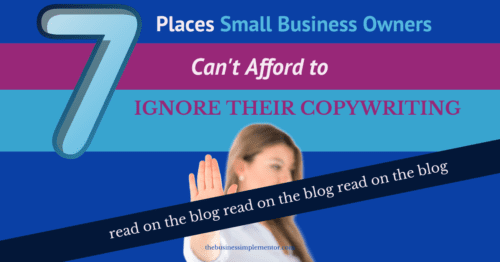When you think of copywriting, do visions of persuasive sales pages, compelling squeeze pages, and highly targeted marketing emails come to mind?
You are not the only one with this assumption, however, copywriting is more than just sales messages. As an online business owner, a certain amount of what you create can be considered copywriting in one way or another. Creating content that intends to draw attention and promote something -that’s precisely what defines effective copywriting.
While it’s natural to go on Facebook and chat with friends, watch funny videos, or take a few quizzes for fun; business owners must remember that it is also an ideal place to connect with prospective customers. Therefore when you’re sharing your recent blog post or program amongst your professional friends, make sure the copywriting you are using is as captivating as possible.
Crafting captions for Facebook is an art form – copywriting. Copywriters are tasked with producing persuasive text to encourage readers to take action, be it purchasing a product or embracing an idea. By using the power of words, this type of writing engages the reader and delivers a concise message in just a few sentences.
Crafting the perfect Facebook caption is essential to engage with followers and conveying your message. Whether it’s a call-to-action, promotion, or just sharing helpful information – capturing readers’ attention with compelling copy will drive them further down the rabbit hole of content you have created. Captivate your audience by writing captions that draw in their interest and direct them to take action.
Crafting the perfect captions for Facebook calls for writing in a manner that is specific to your target audience and platform. For instance, you may need to adopt an informal, yet engaging tone on Facebook posts – in comparison with LinkedIn which demands more of a corporate voice.
Crafting captions for Facebook demands the same proficiency as copywriting, including constructing persuasive and fascinating content that effectively transmits a message while instigating readers to take action.
LinkedIn Profile
How can you stand out from other entrepreneurs in your field? On LinkedIn, allow yourself to share why you are the ideal person to resolve the problems of your target customer. Make sure that this is where you show off and flaunt all of your accomplishments! Treat it like a resume by listing only your most remarkable credentials; let them speak for themselves.
Your LinkedIn profile serves as a remarkable instance of copywriting by crafting an article that introduces you skillfully, calls attention to your talents and accomplishments, and encourages prospective employers or clients to reach out.
Crafting a captivating copy for your LinkedIn profile is essential to capture the attention of your target audience and incite them into action. Highlight what sets you apart from the competition, persuasively convey why people should collaborate with or hire you, and communicate all that’s unique about yourself to make sure it resonates powerfully.
To make it simpler for others to discover you, your LinkedIn profile should be stocked with relevant keywords and phrases associated with your industry. This will boost the chances of showing up in search results when someone is interested in learning more about you or what you do.
To put it simply, composing an irresistible LinkedIn profile is a form of copywriting that requires you to incorporate persuasive wording, personalise your content for the people who will be reading it and showcase your special value proposition to leave a lasting impression on potential employers or clients.
About Page
Ready to show off your talents and have a great time while doing it? Remember, the About page is often one of the most viewed on any website. It’s vital for establishing your brand and communicating what you’re all about! The goal is to intrigue people into exploring more in-depth information about your services – be sure to include an invitation for them to do so with a call-to-action at the end of this section.
Crafting an About page for your website involves creating compelling content that effectively introduces and presents your brand, business, or personal story to the world.
It necessitates you to utilise persuasive language designed specifically for your target audience to express a clear value proposition. Writing an About page is not unlike generating captions for Facebook posts or polishing up one’s LinkedIn profile with style and finesse; these all share similar traits of persuasion in their design.
Utilise your About page to craft an emotional connection with potential customers, by expressing the story behind who you are, and what values and mission underpin your work – not only that but also why you are a better choice than anyone else. Showcase yourself to stand out from competitors and offer visitors the compelling reasons they should pick you over any other options.
Furthermore, just like any other successful copywriting piece, your About page should be both captivating and simple to understand. It ought to follow a clear structure that drives readers towards the next step – whether it is subscribing for updates, buying something from you or booking an appointment with you.
Your compelling call to action will help encourage them into taking this action.
Your website’s About page is a vital aspect of copywriting that shapes the core of your brand and aids in developing relationships with customers. It requires essential skills such as persuasive discourse, audience targeting, and a straightforward value proposal; plus the aspiration to build faithfulness and motivate action.
Blog Posts
No matter their purpose, all blog posts share a common goal: to compel readers into taking the next step. Whether it’s leading them to a sales page, demanding they subscribe to your mailing list, igniting conversation or simply delivering great content and inspiring clicks on related posts – copywriting is always integral in achieving these objectives.
Crafting compelling blog posts is a hallmark of successful copywriting and can be used for purposes ranging from educating an audience about something to pushing products or services, as well as sharing news or simply providing entertainment. By creating content that is informative, engaging, and persuasive you will ensure your readership remains engaged with what you have to offer them.
Crafting a successful blog post is an intricate process that consists of conducting research, formulating ideas and putting them together in an interesting and organised way. To make it both relevant to your audience and captivating, you must select the right topic, gather reliable data and express yourself with clarity. Your words must be succinct yet persuasive enough to keep readers hooked while they read every sentence.
Good copywriting for blog posts also involves structuring your content in a way that is easy to navigate, using headings, subheadings, and bullet points to break up the text and make it more digestible. You should also include visuals, such as images and videos, to help illustrate your points and make your content more engaging.
Good copywriting for blog posts requires you to optimise your content for search engines, using keywords and phrases that are relevant to your topic and industry to improve your search engine ranking and drive more traffic to your site.
Writing blog posts is a form of copywriting that requires research, planning, and execution, to produce informative, engaging, and persuasive content that speaks directly to your audience, drives traffic to your site, and achieves your marketing goals.
Working with a limited window of 140 characters can seem daunting when crafting meaningful content, but this is precisely what you must do to succeed in building an effective marketing agenda with Twitter.
Think of tweets like email subject lines, and craft them to convey as much information as possible while still enticing readers to take action. Twitter is another example of copywriting because it involves crafting short, compelling messages that capture the attention of your followers and convey your message or idea concisely and effectively.
Twitter is a platform that emphasises brevity, with a character limit of 280 characters per tweet. As such, writing effective copy for Twitter requires a different approach than other forms of copywriting. You must be able to convey your message in a way that is clear, engaging, and memorable, using language that is simple and direct.
To maximise the reach of your tweets and interact with followers, make sure to incorporate hashtags and mentions in your copywriting for Twitter.
Hashtags are terms or phrases preceded by a # sign which enables other tweets about similar topics to be grouped; meanwhile, if you place an @ symbol before someone’s username it is called a mention – this allows you to tag another user thus having their attention drawn towards your tweet.
In addition, good copywriting for Twitter requires you to be timely and relevant, using trending topics and current events to engage with your audience and stay top of mind. You should also be consistent in your messaging and branding, using your tweets to reinforce your unique value proposition and build a strong online presence.
Writing good messages on Twitter is a type of writing. You need to be direct, use hashtags and tags to talk with people and write about things that are important and support what makes your account special. This will help you build an online presence.
Whether you’re sending an email about a new product or service or simply letting readers know you have a new blog post up, your email qualifies as copywriting. Even the personal emails you send to prospective clients contain what we would call copywriting.
Writing good words is important for businesses. This includes sales pages and invoices. Writing words that make readers take action is important. The more you know about this, the easier it will be to write great things.
Yes, email marketing is one of the most classic examples of copywriting because it involves crafting persuasive messages that convince your subscribers to take a specific action, such as making a purchase or signing up for a service.
When writing effective emails, you need to grab the attention of your readers right from the subject line, which requires a catchy and compelling headline that entices them to open the email. Once opened, the email body should deliver on the promise of the subject line and provide valuable information or an offer that is relevant and useful to the reader.
Good email copywriting also involves creating a sense of urgency or scarcity to encourage your subscribers to take action quickly, using persuasive language that speaks directly to their needs and desires, and including a clear call-to-action (CTA) that tells the reader what you want them to do next.
Email copywriting means making your message special and useful for the people who will read it. You can separate your email list so that each person gets something interesting to them. It is also important to make sure your emails look good on phones since many people use their phones to check their emails.
Writing effective emails is a form of copywriting that requires a strategic approach, persuasive language, personalization, and a clear call to action. By crafting compelling email messages, you can build stronger relationships with your subscribers, drive engagement and sales, and ultimately grow your business.
Here are some general tips for copywriting in various places, even if you don’t consider yourself a professional copywriter:
- Know your audience: Before you start writing, make sure you have a clear understanding of who you are writing for. Who are they? What are their needs, interests, and pain points? The more you understand your audience, the easier it will be to craft messaging that resonates with them.
- Keep it simple: In all forms of copywriting, simplicity is key. Use clear and concise language, avoid jargon or technical terms, and focus on communicating your message as simply and directly as possible.
- Emphasise benefits: When promoting a product or service, focus on the benefits rather than just the features. How will your product or service make your customers’ lives better? What problems does it solve for them?
- Use storytelling: People love stories, so use them to your advantage. Whether you’re writing a blog post, social media caption, or email, incorporating storytelling elements can make your message more engaging and memorable.
- Be authentic: Authenticity is crucial in copywriting. Be honest and transparent, and avoid making exaggerated claims or using manipulative tactics.
- Edit and revise: Once you’ve written your copy, take the time to edit and revise it. Check for spelling and grammar errors, tighten up your sentences, and make sure your message is clear and concise.
- Test and iterate: Finally, don’t be afraid to test and iterate your copy. Use analytics to track your results, and make adjustments as needed to improve your messaging and achieve better results over time.
Nowadays, copywriting is important for both people and businesses. It helps with writing captions for social media, emails, and other things. Good copywriting can help people pay attention to your business more, remember it better, and buy more of your stuff.
To be a good copywriter, you need to know who you are writing for. Write in a simple way that explains the benefits of what you are selling. Tell stories if it helps. Make sure your writing is honest and read it again to make sure it is right.








